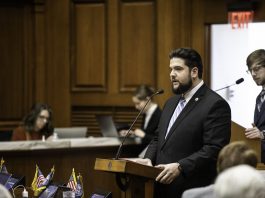“As communities recover from the COVID-19 national health emergency, water utility services continue to be vital to support public health and protect the environment,â€Â said EPA Administrator Andrew Wheeler. “With these actions, EPA is doubling down on its support for the water sector, proving that our research program, key partnerships with states, and innovative thinking are helping our nation’s water systems get even safer and healthier.â€
EPA is using new and emerging technologies to help provide an early indication of COVID-19 infection in communities. EPA researchers are working with the Centers for Disease Control and Prevention (CDC) to develop and evaluate methods for detecting different forms of RNA from SARS-CoV-2, the virus that causes COVID-19. Once developed, researchers will use the methods to quantify the levels detected in untreated wastewater. This research also involves interpreting the data generated by these analytical methods and accurately relating virus levels in wastewater to potential infection trends within the community. This work is being conducted in coordination with CDC, U.S. Department of Health and Human Services, and other federal agencies through the National Sewage Surveillance Interagency Leadership Committee. This research, both in the near term and after full validation, can assist local and state decision-making related to COVID-19.
“The water sector is a key partner in our efforts to reduce the spread of coronavirus,â€Â said EPA Assistant Administrator for Water David Ross. “The cutting-edge tools that we are working to provide are giving the water sector and public health officials the data and information they need to make critical decisions in our joint efforts to recover and safely reopen our nation’s schools, businesses, and communities.â€
Ohio Pilot Project
EPA has been working with the State of Ohio to develop a wastewater monitoring plan for SARS-CoV-2 to inform public health decisions. The initial focus of this research was to rapidly assess approaches for detecting SARS-CoV-2 within wastewater. Once the approach was identified, EPA researchers began using it to analyze wastewater samples from treatment plants across southwestern Ohio, including Cincinnati and Dayton. EPA researchers are working with state and local health departments to estimate rates of infection within these communities.
“Our researchers are uniquely qualified to respond quickly during national public health emergencies and understood that they could apply their research on wastewater sampling and analysis to inform current public health decisions and needs,â€Â said Principal Deputy Administrator for the Office of Research and Development and Acting EPA Science Advisor Jennifer Orme-Zavaleta. “We have long-standing relationships with our partners in Ohio and were able to quickly determine their needs and put together a research program that could inform Ohio and provide an approach for communities across the state.â€
“Monitoring raw wastewater in sewage collection systems provides Ohio with early-warning information that helps community leaders make proactive decisions to prevent outbreaks,â€Â said Ohio Governor Mike DeWine. “Assistance from the U.S. EPA’s Office of Research and Development has been crucial in this work to help limit the spread of coronavirus in Ohio.â€
Earlier this month, Ohio began posting the wastewater monitoring results on its public Coronavirus Dashboard for use by the Governor and state health department as an additional metric for determining public health advisory levels. EPA’s collaboration with the State of Ohio not only expands the sampling capacity of the wastewater monitoring effort, but increases its effectiveness by informing analytical approaches, facilitating interlaboratory comparisons, and standardizing data reporting approaches across utilities and labs. The efforts of early adopting states, like Ohio, are being used by CDC to develop recommended approaches for a SARS-CoV-2 National Wastewater Surveillance System.
COVID-19 Water Sector Survey
To support continued water sector resiliency, EPA is conducting a voluntary survey to learn how drinking water and wastewater utilities across the country have been affected—operationally and financially—by COVID-19. The 2020 COVID-19 Water Sector Survey will help identify and evaluate certain impacts to water utilities stemming from operational and financial challenges. This voluntary survey will facilitate the collection of useful information in a uniform format to guide the development of technical assistance which could help sustain water utility operations and supports planning for the future. Information collected in the survey will be anonymized prior to any public release.



